What is Risk mitigation? A strategic guide
Browse topics
Companies face many risks that can threaten their operations, reputation, and bottom line. Business risks—such as financial, operational, and strategic threats—must be identified and addressed to protect the organization.
With the right risk mitigation strategies, companies can proactively identify, assess, and manage these risks to minimize their impact and ensure business continuity.
We’ll walk through what is risk mitigation and offer valuable insights and strategies for businesses to safeguard their interests. Business leaders must establish effective risk mitigation strategies and foster a risk-aware culture.
These will include the various types of risks and why mitigating them is crucial, key risk mitigation strategies, and five steps for successful risk mitigation implementation.
What is risk mitigation?
Risk mitigation is the process of minimizing risk exposure and reducing the likelihood of an event occurring. It’s essential for organizations to ensure resilience against unavoidable risks and support business continuity.
The goal of risk mitigation is to prepare for and lessen the effects of threats. When done right, you identify potential hazards, evaluate impact, and implement strategies to manage, eliminate, or limit setbacks.
Risk mitigation focuses on specific threats that could impact project objectives, ensuring mitigation strategies align with key outcomes. This ensures business continuity and minimizes negative impacts on the company.
What is risk analysis?
When identifying potential risks, organizations use risk analysis to evaluate possible risks and determine the likelihood of risk events or risks occurring.
When assessing impact, it is crucial to decide on the acceptable level of risk for the organization. When developing mitigation strategies, project planning is a fundamental stage because it ensures clear communication and continuous monitoring of high-impact risks throughout your organization.
What are the most common types of risks?
Companies face various types of risks that can impact their operations, finances, reputation, and overall success such as:
- Strategic risks: These risks develop from fundamental decisions about a company’s objectives—affecting strategy development and implementation. This includes competitive pressure, technological changes, economic shifts, and regulatory changes.
- Operational risks: When potential losses result from inadequate or failed internal processes, people, systems, or events. Born from day-to-day business activities, these risks include internal fraud, external fraud, process failures, system failures, and human error.
- Financial risks: The possibility of losing money or not achieving expected economic outcomes, which impact a company’s financial health, including market, credit, liquidity, operational, and legal risks. Enterprise risk management strategies, such as diversification and hedging, can help mitigate financial risks.
- Compliance risks: Potential for legal penalties, these risks are financial losses or material damage resulting from a company’s failure to adhere to industry laws, regulations, internal policies, or prescribed best practices. This includes privacy breaches, workplace health and safety non-compliance, environmental regulation violations, and involvement in corrupt practices.
- Reputational risks: Involves the potential loss of the company’s reputation, possibly affecting financial standing, market position, and stakeholder trust. Negative publicity, product failures, legal issues, and ethical breaches are often the culprit.
- Natural disaster risks: Earthquakes, floods, or hurricanes can cause significant disruptions or damage to a business or project. Organizations often transfer such risks by purchasing an insurance policy from an insurance company to protect against property damage, business interruption, or financial loss.
- Other risks: Additional unique threats can include recurring risks, which repeatedly pose threats over time. Recognizing recurring risks is essential for prioritizing and monitoring these threats effectively.
Residual risk, the remaining risk after mitigation efforts, should be continuously monitored using a key risk indicator to ensure the effectiveness of risk management strategies.
Why is mitigating risk important?
A robust risk mitigation strategy helps companies protect assets, ensure business continuity, maintain compliance, strengthen stakeholder confidence, inform decision-making, and gain a competitive edge. This strategy gives businesses more opportunity to:
- Identify and address potential threats proactively.
- Minimize the likelihood and impact of the risk.
- Safeguard investments.
- Meet regulatory obligations.
- Build trust with stakeholders.
- Make data-driven strategic decisions.
- Pursue opportunities that risk-averse competitors avoid.
A dedicated risk mitigation team is essential for coordinating these efforts, ensuring that risks are correctly evaluated, prioritized, and managed throughout the organization.
Companies that develop the capability to anticipate, prepare for, and quickly recover from risk-related disruptions can operate with greater resilience in an uncertain business environment.
Common strategies to mitigate risk include avoidance, reduction, transfer, and acceptance. Developing options and selecting appropriate measures are critical steps in addressing risks effectively.
Risk mitigation minimizes the potential impact of identified risks through the following methods:
Avoidance
Risk avoidance is like choosing not to sail into a storm by staying safely in the harbor. It's a conscious decision to avoid certain actions to steer clear of risks, especially when avoiding them is more cost-effective than dealing with potential trouble.
This approach is the opposite of risk acceptance, where you acknowledge the risk but decide to live with it. Risk avoidance is perfect for high-stakes situations where the price of dealing with the risk is just too high.
For instance, a team might pull the plug on a project that's likely to flop, opting to avoid the headache and cost of failure altogether.
Reduction
Risk reduction minimizes the likelihood or impact of a risk through controls, procedures, or safeguards, thereby reducing the chance of a risk happening or occurring. Examples include employee training to reduce human error or implementing cybersecurity measures to mitigate data breach risks.
Transference
Risk transference shifts the risk to another party, often through insurance. Businesses can transfer specific risks to an insurance company by purchasing an insurance policy, which helps manage potential losses.
This is ideal for high-impact risks with significant internal mitigation costs. For example, purchasing liability insurance transfers financial risk to the insurer.
Acceptance
Risk acceptance acknowledges a risk exists but accepts its potential consequences without further mitigation, which is known as a risk acceptance strategy. This approach suits low-likelihood and low-impact risks where mitigation costs outweigh the benefits.
For example, a company may accept the risk of minor equipment failures if redundant systems are too costly.
Monitoring
Continuous risk monitoring ensures mitigation strategies remain effective over time. Effective risk monitoring and the need to monitor risks are essential parts of this process.
This involves regularly assessing risks, tracking key indicators, monitoring progress of mitigation actions, and adjusting strategies to identify and address risks proactively.
5 steps for successful risk mitigation
Effective risk mitigation involves a systematic approach to identifying, assessing, prioritizing, and managing potential threats. Develop a comprehensive risk management plan by following these five steps:
Step 1. Identify all possible risks
The first step in risk mitigation is to uncover all potential risks that could affect your business. This is where you leave no stone unturned.
It involves thoroughly analyzing your operations, industry, and external environment. Make sure that risk identification is closely aligned with your company's business strategy to prioritize hazards that could impact your strategic objectives.
Consider strategic decisions, operational processes, financial stability, legal and regulatory compliance, technology, and reputation risks. Engage stakeholders across the company to gather diverse perspectives and ensure a comprehensive risk inventory.
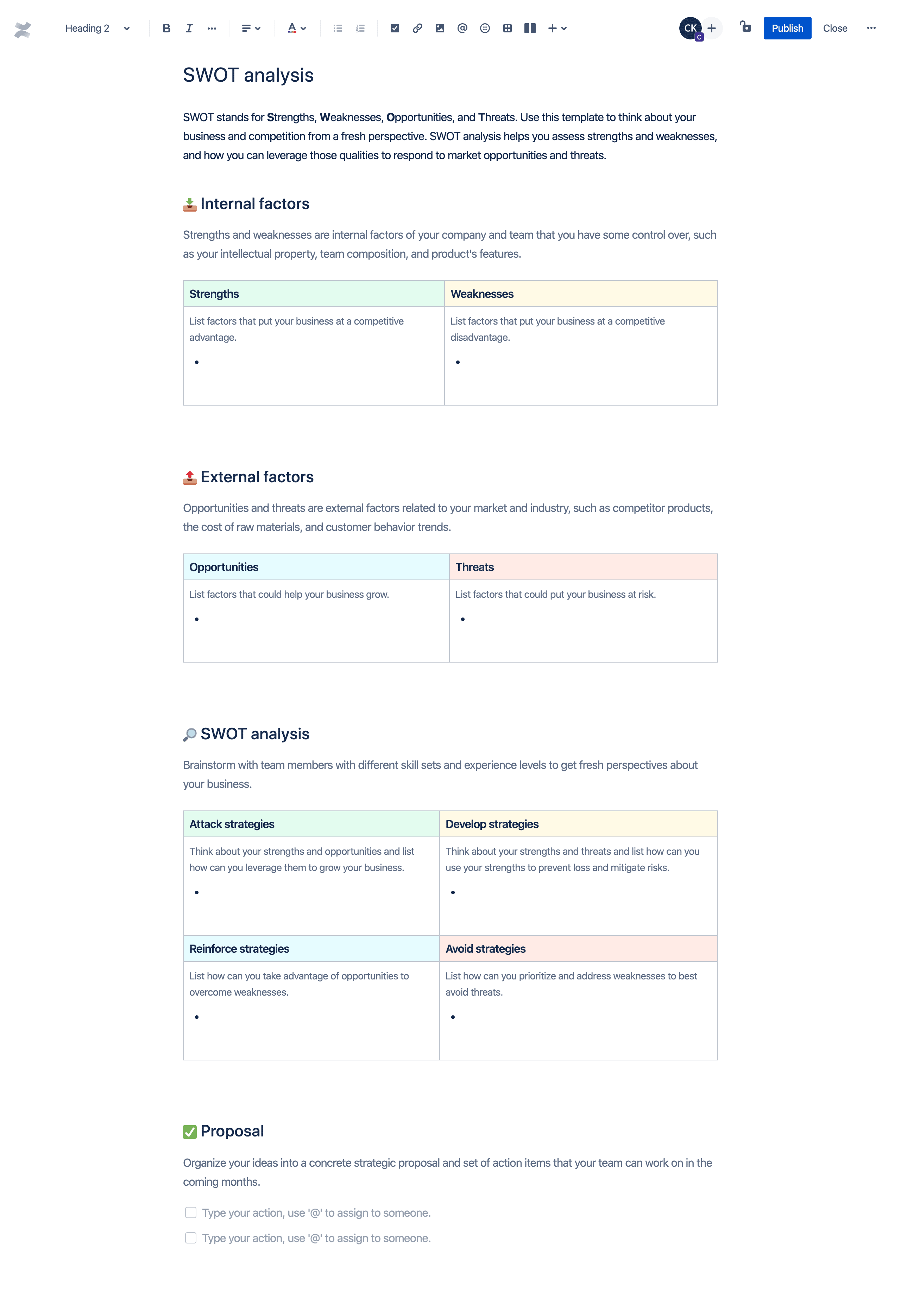
You can also utilize risk identification strategies, such as performing a SWOT analysis or implementing a checklist to ensure no potential risk is overlooked. Confluence templates can be particularly useful in standardizing this process and ensuring comprehensive risk identification.
Step 2. Conduct a risk assessment
After you identify the risks, conduct a detailed risk assessment to determine their likelihood and potential impact. Incorporate risk analysis techniques to systematically evaluate and prioritize risks, supporting your assessment with data-driven insights.
Analyze factors such as the probability of occurrence, the severity of consequences, and the company’s vulnerability.
Use quantitative and qualitative methods to evaluate risks, such as risk matrices, scenario analysis, and expert judgment. Document the results of the assessment in a risk register or risk assessment matrix template.
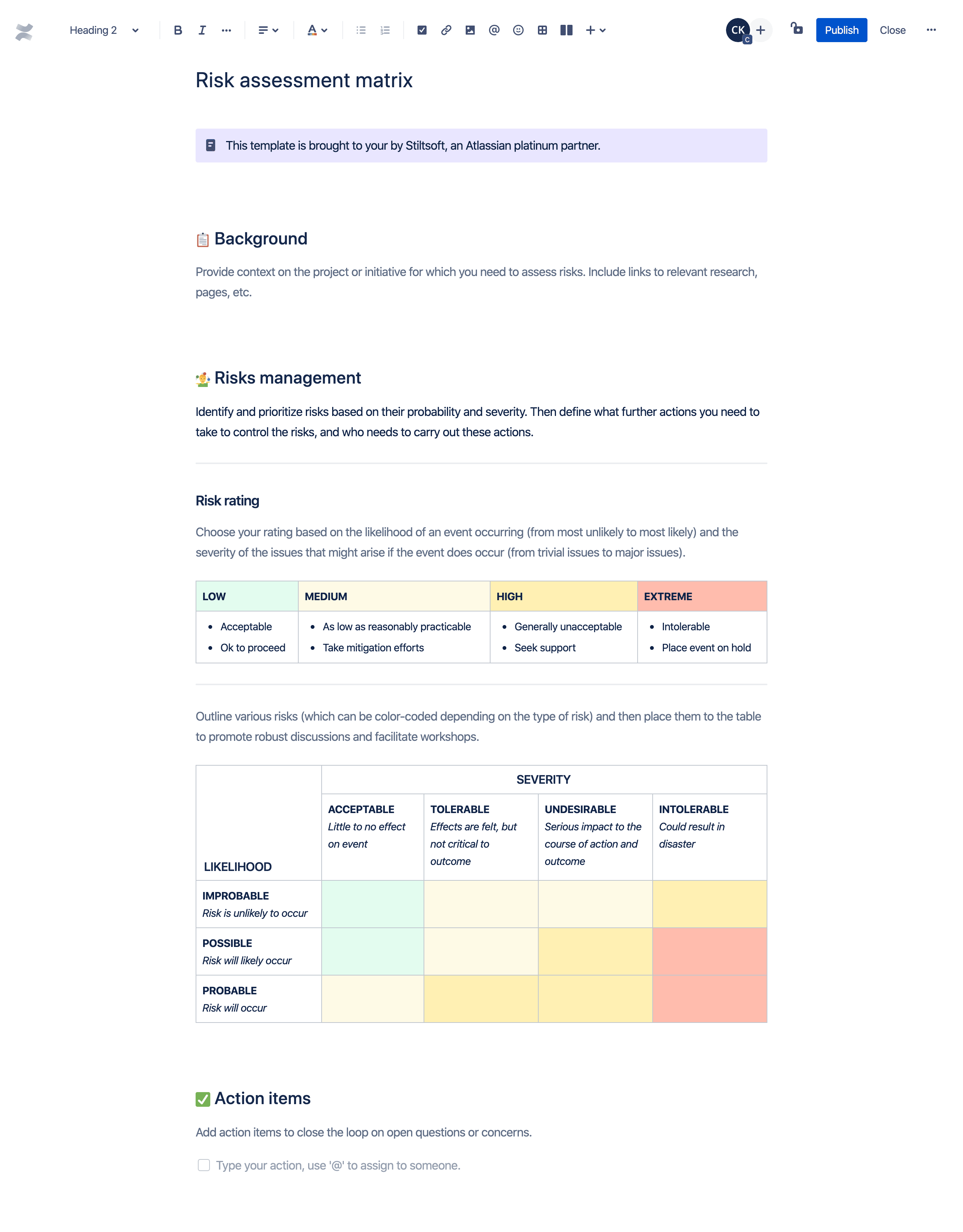
Step 3. Prioritize risks based on potential impact
After conducting the risk assessment, prioritize risks based on their potential impact on the company’s objectives, operations, and stakeholders. Use the results to rank risks according to their likelihood and severity.
Evaluate and compare risk levels to inform which risks should be addressed first and to guide effective prioritization. Focus on high-impact, high-probability risks that require immediate attention and resources.
When setting priorities, consider the company’s risk appetite and tolerance. Tools like Jira can help visualize and tag risks to understand priorities and communicate threats more efficiently.
Step 4. Monitor risk development
Continuously monitor the development of risks and the effectiveness of mitigation measures. Risk monitoring involves tracking key indicators, reviewing the risk register regularly, and assessing the progress of risk mitigation actions.
Identify any changes in the risk landscape, such as emerging risks or priority shifts. Based on monitoring results, adjust the mitigation plan as needed.
Regularly report on risk management activities to senior leadership and stakeholders. Facilitate real-time updates and collaboration, ensuring all relevant parties are informed and aligned.
Step 5. Implement a risk mitigation plan
Develop and implement a comprehensive risk mitigation plan to address the prioritized risks. Include specific strategies and actions to reduce the likelihood and impact of risks.
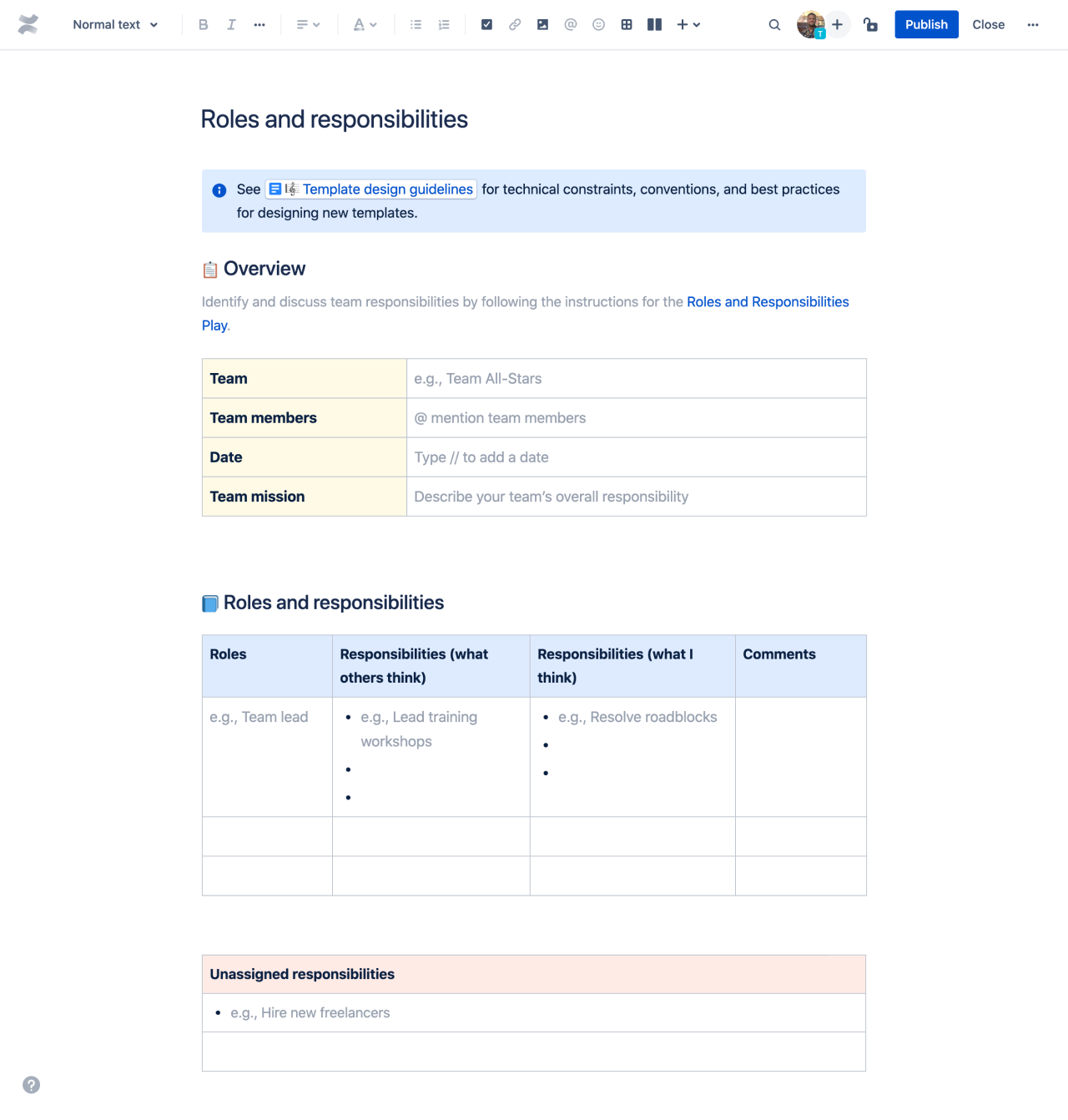
Consider options such as risk avoidance, reduction, sharing, and acceptance. Assign clear roles and responsibilities for implementing risk mitigation measures. Ensure appropriate measures are selected and applied as part of a comprehensive strategy.
Allocate adequate resources and establish timelines for completion. Communicate the risk mitigation plan to all relevant stakeholders.
Risk mitigation best practices
Effective risk mitigation requires a proactive, systematic approach. Implement the following best practices to minimize potential threats and ensure business continuity.
Keep stakeholders in the loop
Transparent communication with stakeholders builds trust and aligns expectations. Regularly update them on identified risks, potential impacts, and planned mitigation strategies.
This fosters a shared understanding of responsibilities and outcomes. Stakeholders can provide valuable insights and support when they feel involved in the risk management process.
Utilize risk management tools
Risk management software such as Jira helps centralize risk data, track risk mitigation efforts, and align risks with broader business goals. Jira's features—such as custom fields, goals, and insights—make identifying, assessing, and prioritizing risks across teams easy.
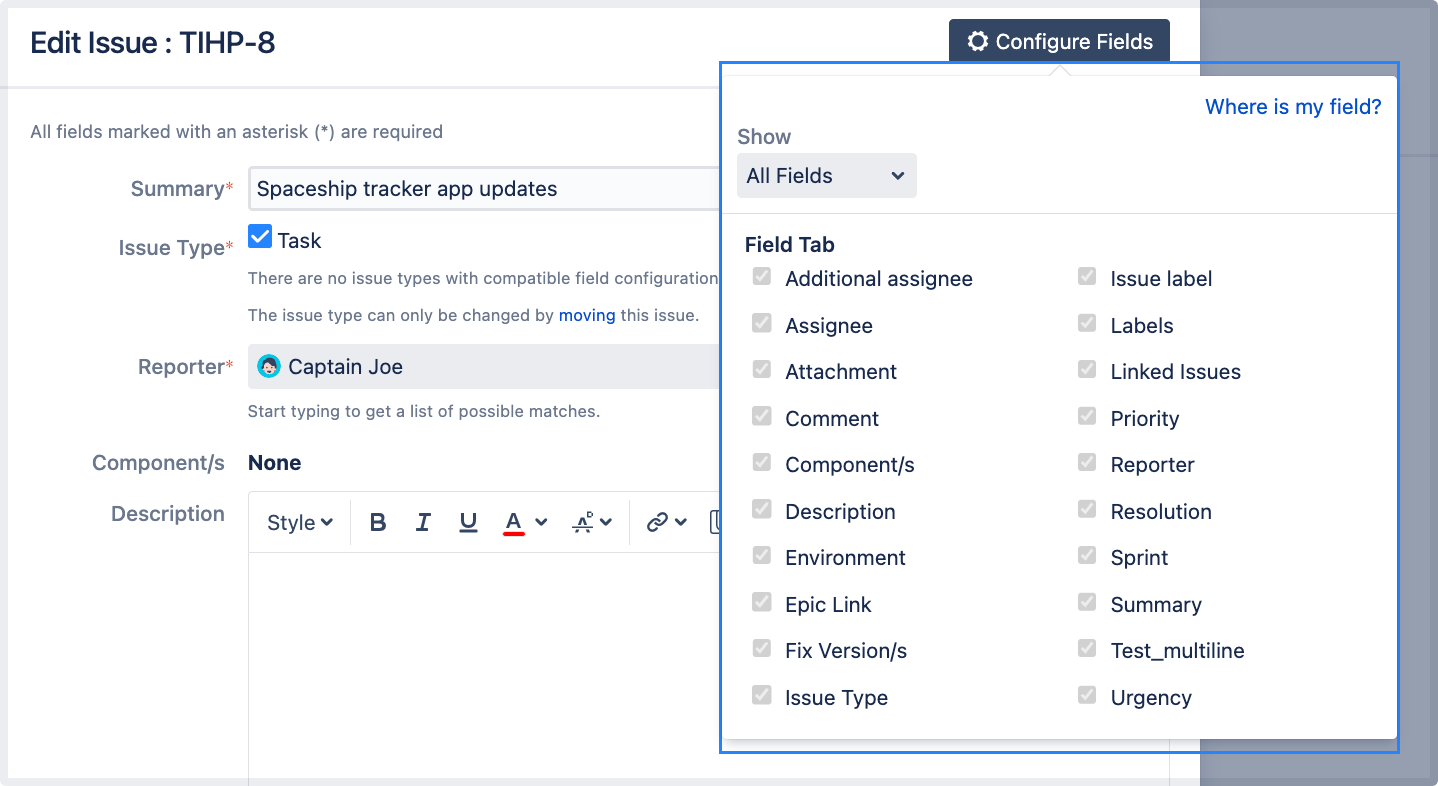
Jira can be used alongside Confluence and Jira Product Discovery for documentation and product planning, providing a unified ecosystem for risk visibility, accountability, and continuous improvement.
Assess risks regularly
Risk assessments should occur regularly and whenever significant changes arise in the company or its environment. A thorough risk assessment identifies potential hazards, evaluates their likelihood and impact, and prioritizes them based on severity.
This proactive approach allows businesses to allocate resources effectively and develop targeted mitigation plans.Project managers can jump-start this process with tools like Jira’s customizable risk tracking workflows and issue types.
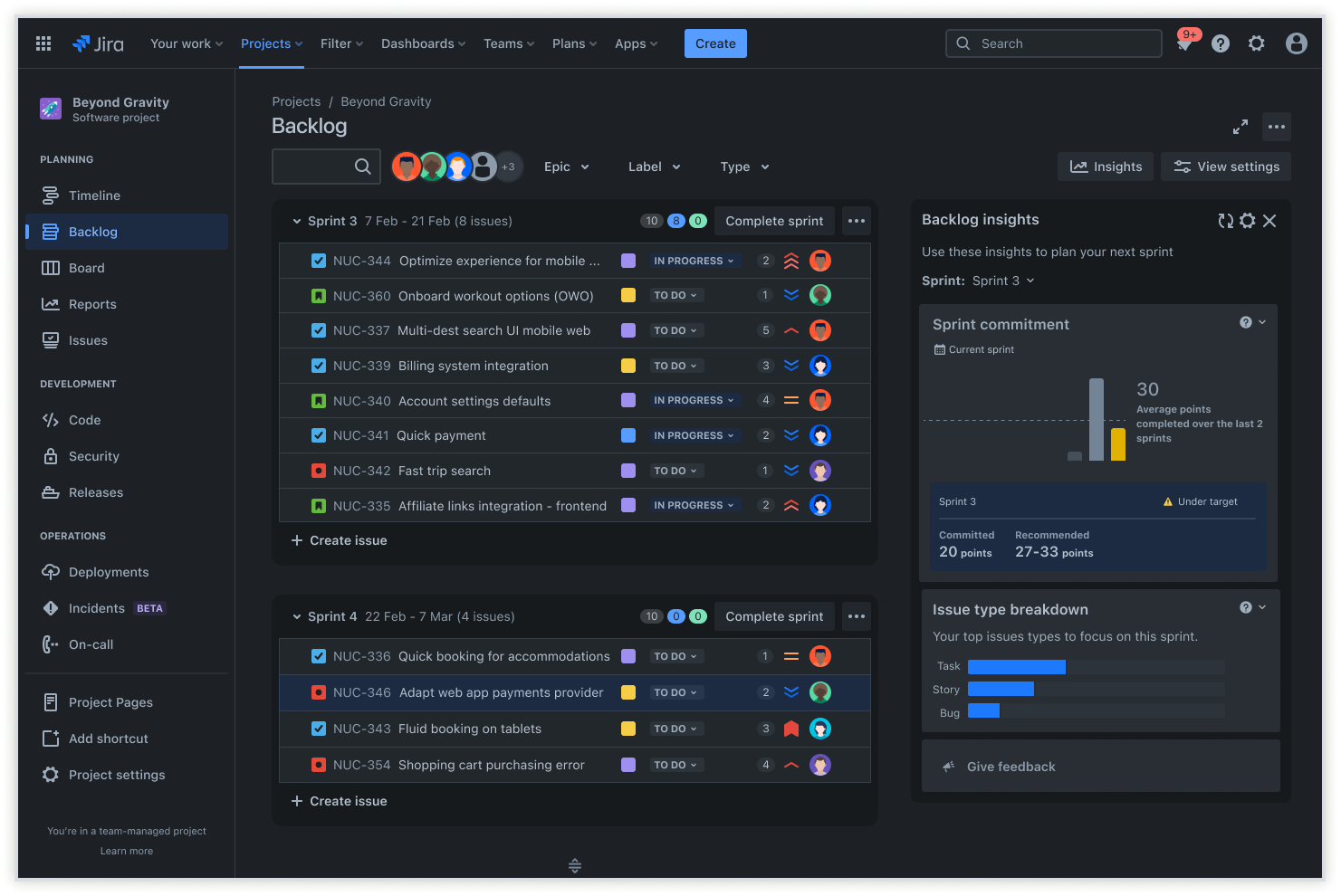
This provides structured frameworks for assessing risk probability, impact, and ownership.
Building a strong risk culture and awareness
Establishing a strong risk culture and awareness across your organization is a cornerstone of effective risk mitigation strategies.
When employees at every level understand the importance of risk assessment, risk avoidance, and risk reduction, they become proactive participants in identifying and managing potential risks.
Regular training sessions, workshops, and awareness programs can equip your team with the knowledge and tools to recognize and report risks before they escalate into adverse events.
Open communication channels are vital—employees should feel empowered to share concerns about risks without fear of blame or reprisal. This transparency helps identify risks early and fosters a sense of shared responsibility for risk mitigation.
By embedding risk awareness into your organizational culture, you create an environment where everyone is vigilant about potential risks and committed to preventing adverse events, ultimately strengthening your company’s resilience.
Stay ahead of risks and ensure your success with Jira
Your company faces countless risks every day that can disrupt projects, impact goals, or threaten operations. And with the help of Jira, you can:
- Create custom fields for tracking risk level, likelihood, and mitigation owner
- Define goals and tie them directly to mitigation efforts and strategic objectives
- Use Jira insights to identify trends, blockers, and risks across initiatives
- Visualize risk severity with customizable dashboards and reports
- Integrate seamlessly with Confluence to document risk assessments and collaborate cross-functionally
Bring clarity and control to risk management by connecting risk mitigation strategies directly to work execution.